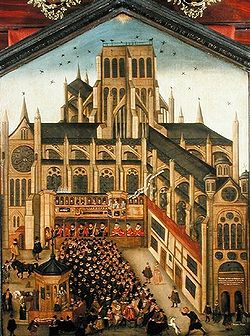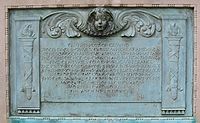
St Paul's Cross
Encyclopedia

Preaching cross
A preaching cross is a cross, sometimes surmounting a pulpit, erected out of doors to designate a preaching place.In Britain and Ireland, many free-standing upright crosses – or high crosses – were erected. Some of these crosses bear figurative or decorative carvings, or inscriptions in runes...
and open air pulpit
Pulpit
Pulpit is a speakers' stand in a church. In many Christian churches, there are two speakers' stands at the front of the church. Typically, the one on the left is called the pulpit...
in the grounds of Old St Paul's Cathedral
Old St Paul's Cathedral
Old St Paul's Cathedral is a name used to refer to the medieval cathedral of the City of London which until 1666 stood on the site of the present St Paul's Cathedral. Built between 1087 and 1314 and dedicated to St Paul, the cathedral was the fourth church on the site at Ludgate Hill...
, City of London
City of London
The City of London is a small area within Greater London, England. It is the historic core of London around which the modern conurbation grew and has held city status since time immemorial. The City’s boundaries have remained almost unchanged since the Middle Ages, and it is now only a tiny part of...
.
History
The first 'folkmoot' (or general assembly of the people) known to be held here was by John Mansell, a king's justice, on St Paul's Day in 1236, to announce to them that Henry IIIHenry III of England
Henry III was the son and successor of John as King of England, reigning for 56 years from 1216 until his death. His contemporaries knew him as Henry of Winchester. He was the first child king in England since the reign of Æthelred the Unready...
wished London to be well-governed and its liberties guarded. The Archbishop of Canterbury and the King attended the next such meeting we know of, in 1259, at which Londoners came to swear their allegiance to the latter and to his heirs (though under duress, as a royal army was holding the city gates at this time). They also gathered here later to swear allegiance to Henry's opponent Simon de Montfort
Simon de Montfort, 6th Earl of Leicester
Simon de Montfort, 6th Earl of Leicester, 1st Earl of Chester , sometimes referred to as Simon V de Montfort to distinguish him from other Simon de Montforts, was an Anglo-Norman nobleman. He led the barons' rebellion against King Henry III of England during the Second Barons' War of 1263-4, and...
.

Worcester
The City of Worcester, commonly known as Worcester, , is a city and county town of Worcestershire in the West Midlands of England. Worcester is situated some southwest of Birmingham and north of Gloucester, and has an approximate population of 94,000 people. The River Severn runs through the...
, a chaplain, pleaded guilty to sorcery charges here in c.1422 but, after forswearing such practices and being arraigned by the Bishop of Llandaff
Bishop of Llandaff
The Bishop of Llandaff is the Ordinary of the Church in Wales Diocese of Llandaff.-Area of authority:The diocese covers most of the County of Glamorgan. The Bishop's seat is located in the Cathedral Church of Saint Peter and Saint Paul , in the village of Llandaff, just north-west of the City of...
(then John de la Zouche), he was marched to Cheapside
Cheapside
Cheapside is a street in the City of London that links Newgate Street with the junction of Queen Victoria Street and Mansion House Street. To the east is Mansion House, the Bank of England, and the major road junction above Bank tube station. To the west is St. Paul's Cathedral, St...
with his 2 magic books open upon him, where the books were burnt and he freed without any other punishment. Reginald Pecock
Reginald Pecock
Reginald Pecock was an English prelate, Scholastic, and writer.-Life:Pecock was probably born in Wales, and was educated at Oriel College, Oxford....
, Bishop of St. Asaph, attacked Lollardy
Lollardy
Lollardy was a political and religious movement that existed from the mid-14th century to the English Reformation. The term "Lollard" refers to the followers of John Wycliffe, a prominent theologian who was dismissed from the University of Oxford in 1381 for criticism of the Church, especially his...
from this cross in 1437 but himself did public penance there in 1447 (by which time he was Bishop of Chichester
Bishop of Chichester
The Bishop of Chichester is the Ordinary of the Church of England Diocese of Chichester in the Province of Canterbury. The diocese covers the Counties of East and West Sussex. The see is in the City of Chichester where the seat is located at the Cathedral Church of the Holy Trinity...
) before a mob of 20,000 and the Archbishop of Canterbury
John Stafford (archbishop)
John Stafford was an English statesman and Archbishop of Canterbury.-Life:Stafford was the illegitimate son of a Wiltshire squire, which meant that he had to get the Pope's permission to become a clergyman...
, throwing various examples of his own heretical
Heresy
Heresy is a controversial or novel change to a system of beliefs, especially a religion, that conflicts with established dogma. It is distinct from apostasy, which is the formal denunciation of one's religion, principles or cause, and blasphemy, which is irreverence toward religion...
writings into a fire. Thomas Netter
Thomas Netter
Thomas Netter was an English Scholastic theologian and controversialist. From his birthplace he is commonly called Thomas Waldensis.-Life:...
also preached against Lollardy here.
Jane Shore
Jane Shore
Elizabeth "Jane" Shore was one of the many mistresses of King Edward IV of England, the first of the three whom he described respectively as "the merriest, the wiliest, and the holiest harlots" in his realm...
, mistress of King Edward IV
Edward IV of England
Edward IV was King of England from 4 March 1461 until 3 October 1470, and again from 11 April 1471 until his death. He was the first Yorkist King of England...
was brought before the cross in 1483 and divested "of all her splendour".

Thomas Kempe
Thomas Kempe was a medieval Bishop of London.Kempe was the nephew of John Kemp, Archbishop of Canterbury.Kempe was provided to London on 21 August 1448 and consecrated on 8 February 1450. He died on 28 March 1489. He had previously held the office of Archdeacon of Richmond from 1442 to 1448.-...
rebuilt the cross in the late 15th century in grand architectural form, as an open air pulpit of mostly timber with room for 3 or 4 inside it, set on stone steps with a lead-covered roof and a low surrounding wall. From here was preached much of the English Reformation
English Reformation
The English Reformation was the series of events in 16th-century England by which the Church of England broke away from the authority of the Pope and the Roman Catholic Church....
, along with many major events in London's history, with sermons preached here usually printed and thus redistributed to a wider audience. It was a speech here that triggered the 1517 Evil May Day
Evil May Day
Evil May Day or Ill May Day is the name of a riot which took place in 1517 as a protest against foreigners living in London.- Causes :...
anti-foreigner riots. Ultra-Lutheran Robert Barnes attacked Stephen Gardiner
Stephen Gardiner
Stephen Gardiner was an English Roman Catholic bishop and politician during the English Reformation period who served as Lord Chancellor during the reign of Queen Mary I of England.-Early life:...
from it, and in 1566 Matthew Hutton, later Archbishop of York
Archbishop of York
The Archbishop of York is a high-ranking cleric in the Church of England, second only to the Archbishop of Canterbury. He is the diocesan bishop of the Diocese of York and metropolitan of the Province of York, which covers the northern portion of England as well as the Isle of Man...
, preached here. The first sermon preached here after Catholic Queen Mary
Mary I of England
Mary I was queen regnant of England and Ireland from July 1553 until her death.She was the only surviving child born of the ill-fated marriage of Henry VIII and his first wife Catherine of Aragon. Her younger half-brother, Edward VI, succeeded Henry in 1547...
's accession (by Bishop Bourne
Gilbert Bourne
Gilbert Bourne was the last Roman Catholic Bishop of Bath and Wells, England.-Life to the death of Mary I:Bourne was son of Philip Bourne, of Worcestershire...
) provoked a riot - a dagger was thrown at Bourne (but missed him, sticking in one of the side posts) and he had to be rushed to safety in St Paul's School. Thus, Mary's successor Elizabeth I
Elizabeth I of England
Elizabeth I was queen regnant of England and Ireland from 17 November 1558 until her death. Sometimes called The Virgin Queen, Gloriana, or Good Queen Bess, Elizabeth was the fifth and last monarch of the Tudor dynasty...
kept the pulpit empty for a long time after her accession to keep the people from riot. However, when it finally came to Dr Samson's appearance at the Cross to announce Elizabeth's religious policy, the keys to the Cross's pulpit were found to be mislaid and, when the Lord Mayor ordered the door to be forced, it was found to be too dirty and badly maintained for use on this occasion. However, John Jewel
John Jewel
John Jewel was an English bishop of Salisbury.-Life:He was the son of John Jewel of Buden, Devon, was educated under his uncle John Bellamy, rector of Hampton, and other private tutors until his matriculation at Merton College, Oxford, in July 1535.There he was taught by John Parkhurst,...
was appointed the Cross's select preacher on 15 June 1559, and on 26 November that year challenged all comers to prove the Roman case out of the Scriptures, or the councils or Fathers for the first six hundred years after Christ.
The Puritans
Puritan
The Puritans were a significant grouping of English Protestants in the 16th and 17th centuries. Puritanism in this sense was founded by some Marian exiles from the clergy shortly after the accession of Elizabeth I of England in 1558, as an activist movement within the Church of England...
destroyed the cross and pulpit in 1643 during the First English Civil War
First English Civil War
The First English Civil War began the series of three wars known as the English Civil War . "The English Civil War" was a series of armed conflicts and political machinations that took place between Parliamentarians and Royalists from 1642 until 1651, and includes the Second English Civil War and...
. The cross (but not the pulpit) was reconstructed in 1910 out of funds from the will of Mr. H.C. Richards, KC, MP.
External links
- Britannia.com
- E. Beresford Chancellor's 'St. Paul's Cathedral' (1925)
- Benjamin Vincent's 'A Dictionary of Dates', London 1863

